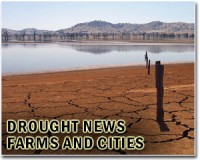| . |  |
. |
Leeds, UK (SPX) Feb 08, 2011 New research shows that the 2010 Amazon drought may have been even more devastating to the region's rainforests than the unusual 2005 drought, which was previously billed as a one-in-100 year event. Analyses of rainfall across 5.3 million square kilometres of Amazonia during the 2010 dry season, published tomorrow in Science, shows that the drought was more widespread and severe than in 2005. The UK-Brazilian team also calculate that the carbon impact of the 2010 drought may eventually exceed the 5 billion tonnes of CO2 released following the 2005 event, as severe droughts kill rainforest trees. For context, the United States emitted 5.4 billion tonnes of CO2 from fossil fuel use in 2009. The authors suggest that if extreme droughts like these become more frequent, the days of the Amazon rainforest acting as a natural buffer to man-made carbon emissions may be numbered. Lead author Dr Simon Lewis, from the University of Leeds, said: "Having two events of this magnitude in such close succession is extremely unusual, but is unfortunately consistent with those climate models that project a grim future for Amazonia." The Amazon rainforest covers an area approximately 25 times the size of the UK. University of Leeds scientists have previously shown that in a normal year intact forests absorb approximately 1.5 billion tonnes of CO2 (1). This counter-balances the emissions from deforestation, logging and fire across the Amazon and has helped slow down climate change in recent decades. In 2005, the region was struck by a rare drought which killed trees within the rainforest. On the ground monitoring showed that these forests stopped absorbing CO2 from the atmosphere, and as the dead trees rotted they released CO2 to the atmosphere. The unusual drought, affecting south-western Amazonia, was described by scientists at the time as a 'one-in-100-year event' (2), but just five years later the region was struck by a similar extreme drought that caused the Rio Negro tributary of the Amazon river to fall to its lowest level on record. The new research, co-led by Dr Lewis and Brazilian scientist Dr Paulo Brando, used the known relationship between drought intensity in 2005 and tree deaths to estimate the impact of the 2010 drought. They predict that Amazon forests will not absorb their usual 1.5 billion tonnes of CO2 from the atmosphere in both 2010 and 2011, and that a further 5 billion tonnes of CO2 will be released to the atmosphere over the coming years once the trees that are killed by the new drought rot. Dr Brando, from Brazil's Amazon Environmental Research Institute (IPAM), said "We will not know exactly how many trees were killed until we can complete forest measurements on the ground. "It could be that many of the drought susceptible trees were killed off in 2005, which would reduce the number killed last year. On the other hand, the first drought may have weakened a large number of trees so increasing the number dying in the 2010 dry season. "Our results should be seen as an initial estimate. The emissions estimates do not include those from forest fires, which spread over extensive areas of the Amazon during hot and dry years. These fires release large amounts of carbon to the atmosphere." Some global climate models suggest that Amazon droughts like these will become more frequent in future as a result of greenhouse gas emissions. Dr Lewis added: "Two unusual and extreme droughts occurring within a decade may largely offset the carbon absorbed by intact Amazon forests during that time. If events like this happen more often, the Amazon rainforest would reach a point where it shifts from being a valuable carbon sink slowing climate change, to a major source of greenhouse gasses that could speed it up. "Considerable uncertainty remains surrounding the impacts of climate change on the Amazon. This new research adds to a body of evidence suggesting that severe droughts will become more frequent leading to important consequences for Amazonian forests. If greenhouse gas emissions contribute to Amazon droughts that in turn cause forests to release carbon, this feedback loop would be extremely concerning. Put more starkly, current emissions pathways risk playing Russian roulette with the world's largest rainforest." The research was a collaboration between the Universities of Leeds, Sheffield and the Instituto de Pesquisa Ambiental da Amazonia (IPAM) in Brazil. The work was funded by the Royal Society, Gordon and Betty Moore Foundation and the US National Science Foundation.
Share This Article With Planet Earth
Related Links University of Leeds Climate Science News - Modeling, Mitigation Adaptation
 China farmers to get $15 bn subsidies amid drought
China farmers to get $15 bn subsidies amid droughtBeijing (AFP) Jan 21, 2011 China says it had earmarked about $15 billion in subsidies for millions of farmers who have been hit by a severe drought that has driven prices as the government tries to battle inflation. The dry spell in the north and south has affected about four million hectares (9.9 million acres), official figures show, and has been blamed for destroying crops. Farmers will receive 98.6 billion yua ... read more |
|
| The content herein, unless otherwise known to be public domain, are Copyright 1995-2010 - SpaceDaily. AFP and UPI Wire Stories are copyright Agence France-Presse and United Press International. ESA Portal Reports are copyright European Space Agency. All NASA sourced material is public domain. Additional copyrights may apply in whole or part to other bona fide parties. Advertising does not imply endorsement,agreement or approval of any opinions, statements or information provided by SpaceDaily on any Web page published or hosted by SpaceDaily. Privacy Statement |